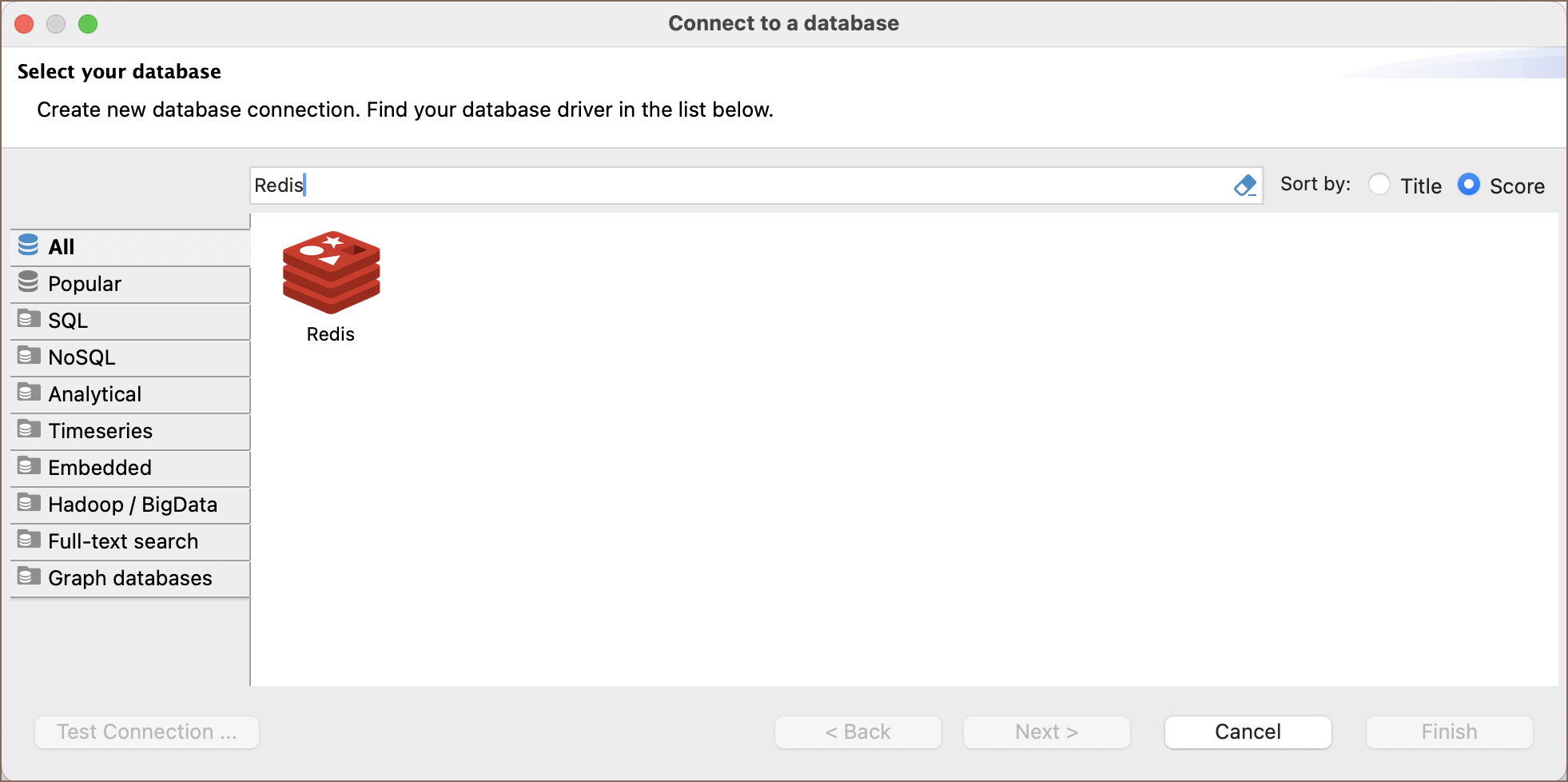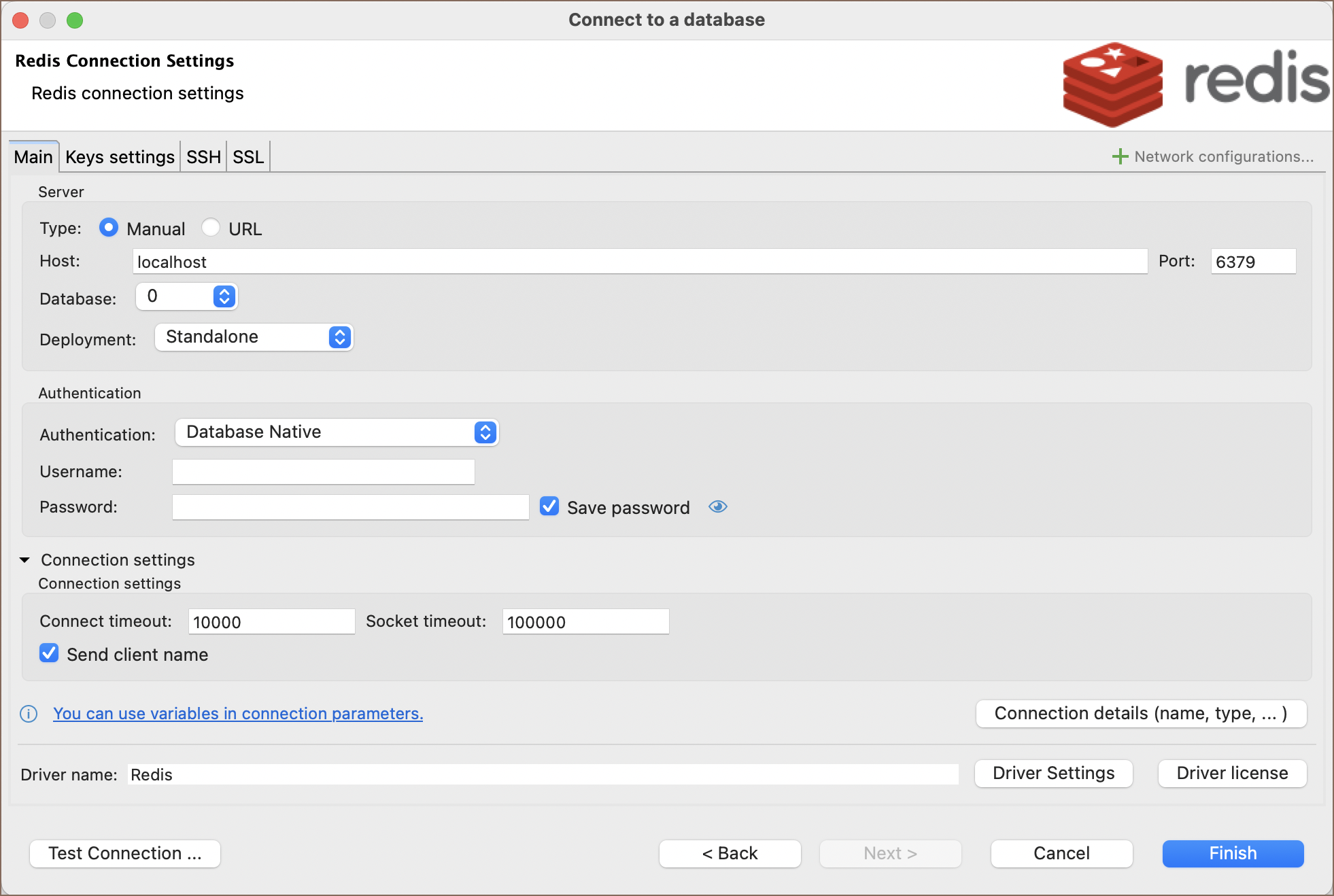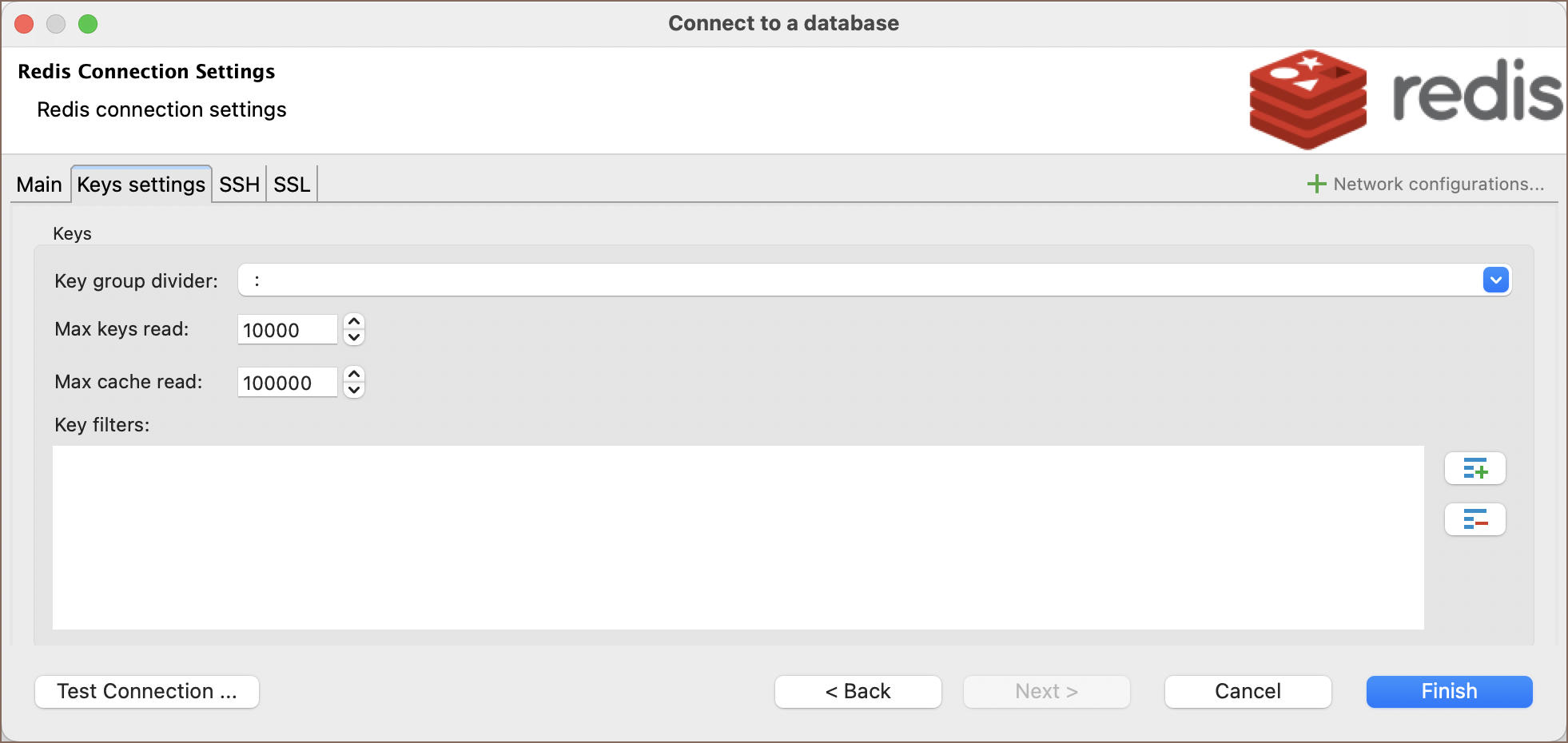Redis
Note: This driver is available in Lite, Enterprise, Ultimate and Team editions only.
This guide provides instructions on how to set up and use Redis with DBeaver.
Before you can start managing your database, it's essential to establish a connection in DBeaver. This involves
selecting the Redis option to connect to the Redis. If you have not yet created a
connection in DBeaver, please refer to our Creating a Connection article for guidance.

Redis is an open-source, in-memory data structure store, used as a database, cache, and message broker. It supports various data structures such as strings, hashes, lists, sets, sorted sets with range queries, bitmaps, hyperloglogs, geospatial indexes, and streams. Redis has built-in replication, Lua scripting, LRU eviction, transactions, and different levels of on-disk persistence. Additionally, Redis offers high availability via Redis Sentinel and automatic partitioning with Redis Cluster.
Redis is particularly well-suited for real-time applications like leaderboards, session stores, real-time analytics, and geospatial services due to its fast performance and support for complex data types and operations. For detailed information on Redis and its features, please refer to the official documentation.
This section provides an overview of DBeaver's settings for establishing a direct connection and the configuration of secure connections using SSH, proxies, Kubernetes and SSL.
In this subsection, we will outline the settings for establishing a direct connection to a Redis database using DBeaver. Correctly configuring your connection ensures seamless interaction between DBeaver and your Redis database.
- The first page of the connection settings requires you to fill in specific fields to establish the initial connection.

| Field | Description |
|---|---|
| Connect by (Manual/URL) | Choose whether you want to connect using a host or a URL. |
| URL | If you are connecting via URL, enter the URL of your Redis database here. This field is disabled if you're connecting via the host. |
| Host | If you are connecting via host, enter the host address of your Redis database here. |
| Database | Enter the database number you want to connect to. |
| Port | Enter the port number for your Redis database. The default Redis port is 6379. |
| Deployment | Select the type of Redis deployment for your connection. Options include: |
| - Standalone: A single-node Redis deployment. | |
| - Redis Cluster: A multi-node Redis deployment for higher performance and fault tolerance. | |
| - Redis Sentinel: A system designed to help manage Redis instances, providing high availability and monitoring services. | |
| Authentication | Choose the type of authentication you want to use for the connection. For detailed guides on authentication types, please refer to the following articles: - Native Database Authentication - DBeaver Profile Authentication - Redis Sentinel (coming soon) You can also read about security in DBeaver PRO. |
| Connection settings | Customize connection settings: |
Connect timeout: Specify the duration, in milliseconds, the application waits to establish a connection before it times out. 10000 milliseconds is the default value. |
|
Socket timeout: Set the time, in milliseconds, the application waits for a server response to a query. The default setting here is 100000 milliseconds. |
|
| Send client name: Check this option to transmit the client's name to the server when connecting. Some Redis servers do not support this feature, which may cause the connection attempt to fail. | |
| Connection Details | Provide additional connection details if necessary. |
| Driver Name | This field will be auto-filled based on your selected driver type. |
| Driver Settings | If there are any specific driver settings, configure them here. |
-
The second page of the connection settings offers additional options that allow you to customize the keys settings.

| Setting | Description | Default Value |
|---|---|---|
| Key group divider | Determines the delimiter used to group keys in the keyspace. | : |
| Max keys read | Limits the number of keys to read. | 10000 |
| Max cache read | Specifies the number of keys to read with pattern (cache). | 100000 |
| Key filters | Allows you to define patterns to include or exclude certain keys. | * |
The Connection Details section in DBeaver allows you to customize your experience while working with Redis database. This includes options for adjusting the Navigator View, setting up Security measures, applying Filters, configuring Connection Initialization settings, and setting up Shell Commands. Each of these settings can significantly impact your database operations and workflow. For detailed guides on these settings, please refer to the following articles:
- Connection Details Configuration
- Database Navigator
- Security Settings Guide
- Filters Settings Guide
- Connection Initialization Settings Guide
- Shell Commands Guide
DBeaver supports secure connections to your Redis database. Guidance on configuring such connections, specifically SSH, Proxy, Kubernetes, and SSL connections, can be found in various referenced articles. For a comprehensive understanding, please refer to these articles:
DBeaver is not limited to typical SQL tasks. It also includes numerous additional features compatible with Redis, but not exclusive to it:
| Category | Feature |
|---|---|
| Data Transfer | Data Import |
| Data Export | |
| Task Management | Task Management |
Redis keys are often viewed and edited as a simple list. However, when dealing with a large number of keys, which can run into millions or billions, a list view is not always practical or possible.
DBeaver offers a hierarchical view of Redis keys. Although Redis itself does not inherently support hierarchical data structures, it is common practice to organize keys into groups using specific delimiters like commas, dashes, or colons. DBeaver leverages these naming patterns to display keys in a hierarchical format. You can configure the group separator in the connection properties.
The key browser feature is useful, but for databases with a large key count, locating a specific key through the navigator might be challenging. In such cases, using the SQL editor with Redis commands is the most effective method to manage keys.
Redis operates differently from traditional SQL databases. It uses built-in commands and LUA scripting for operations.
To execute Redis commands, use the syntax similar to the Redis command line shell:
SET mykey "Hello"
This command will set the value of mykey to Hello. To run this command in DBeaver, you would type it into the SQL
editor and execute it using either CTRL+Enter or ALT+X.
To learn more about Redis commands, refer to the official Redis commands documentation.
For LUA script execution, enclose the script in curly braces {} and execute it as a single statement. If your LUA script includes empty lines or special characters, highlight the script text before executing it. For instance:
{
-- Retrieve the value of a Redis key
local key = 'key1038' -- Specify the key you want to retrieve
local value = redis.call('GET', key)
return value
}
For LUA scripting in Redis, see LUA scripts in Redis.
-
Views
-
Search
-
Projects
- Sample Database
-
Database Connections
- Edit Connection
- Invalidate/Reconnect to Database
- Disconnect from Database
- Change current user password
- Advanced settings
- Cloud configuration settings
- Local Client Configuration
- Connection Types
- Configure Connection Initialization Settings
-
Tableau integration

- Transactions
- Drivers
- Tasks
-
Cloud Explorer

-
Cloud Storage

- Classic
- Cloud
- Changing interface language
- DBeaver extensions - Office, Debugger, SVG
- Installing extensions - Themes, version control, etc
- User Interface Themes
- Command Line
- Reset UI settings
- Reset workspace
- Troubleshooting system issues
- Posting issues
- Log files
- JDBC trace
- Thread dump
- Managing connections
- Managing variables
- Managing drivers
- Managing preferences
- Managing restrictions
- Windows Silent Install
- Snap installation